October 31, 2024
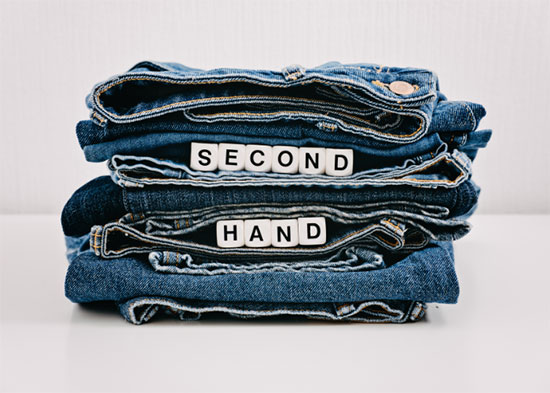
Secondhand fashion is a force. Driven by a confluence of issues, including the economy, a desire for quality and concern about global warming, more consumers are turning to thrifting. And of course, it’s not just limited to Goodwill anymore. Brick and mortar thrift stores are now just one part of the overall ecosystem that includes online peer-to-peer marketplaces like eBay as well as managed sites that handle the legwork and, in some cases, authenticate goods (think TheRealReal). And increasingly brands and retailers have entered the fray, as a way to retain customers and demonstrate their commitment to sustainability.
The global secondhand apparel market is set to reach $350 billion by 2028, according to Thredup’s 2024 Resale Report. Secondhand is growing 3x faster than the global apparel market. Put another way, the company says, 2 in 5 apparel items bought in the last 12 months were secondhand. Young shoppers are responsible for much of this surge with Gen Z nearly twice as likely to shop secondhand as their older counterparts, according to a new Shipstation report.
And shoppers are actively looking for thrifting opportunities. The eBay 2024 Recommerce Report found that the global number of clothing, shoes and accessories sold with “thrifted” in the description increased by over 400 percent in March 2024 vs. March 2023.
The reasons are varied. In some cases, it’s because consumer dollars are stretched, and they see resale as a better value proposition. In others, shoppers feel they can find better quality with resale. Also, some feel they’re able to trade up for items they otherwise wouldn’t be able to afford. Others want to curtail the amount of goods that wind up in landfills. Still others simply enjoy the hunt.
“The question is not should we enter the second hand market, but how,” according to logistics and supply chain solutions company Geodis, calling secondhand “a strategic imperative for apparel and luxury brands.”
To truly capitalize on its potential, the industry must adopt new processes and technologies to foster growth.
For products, that means building items that will last. In short, circular design, product development and material innovation methods must be employed. Apparel company Dôen keeps secondhand in mind when designing each collection. “We create goods with longevity in mind, not just from a product durability and quality standpoint, but also in terms of the design aesthetic, creating classic, timeless silhouettes that really don’t go out of style,” Kristine Kim, the company’s senior director, impact and responsible sourcing said at the Sourcing Journal x Rivet Sustainability LA event last month.
Studies have shown that shoppers are more likely to buy new items if they feel it will hold its value and provide a resale opportunity. Resale value is often also tied to authentication, particularly in the luxury space. This means brands and retailers must up their traceability and transparency tools. Vogue Business reports that some brands like Coach, Tod’s and Breitling are leveraging digital IDs to deliver product, authenticity and sustainability information. With the mandate for digital product passports on the horizon, the industry could leverage this new technology to tie brands to garment owners, whether they’re the first, second or beyond. In some cases, this digital tether could allow companies to profit each time the item changes hands or simply create brand awareness with future owners.
Daniela Ott, strategic advisor of Authentique, told the publication connecting DPPs directly with secondhand marketplaces “provides a huge opportunity for the brands to become part of the conversation about resale and not entirely leave this to third-party platforms.”
In fact, some brands are already finding value in fully participating in the resale space—and a large portion of consumers prefer it that way. Thredup has found that of secondhand shoppers who opt to purchase through the brand directly, more than half report they do so because they trust the brand more than marketplaces. While it may seem risky to offer shoppers a potentially lower priced item alongside full price goods, those that do are reaping the rewards. Home textile brand Coyuchi sells new and resale items side by side on its site and the company told Sourcing Journal that nearly 40 percent of carts feature products from each category. Other brands report that resale helps them capture consumers looking for an entry price point into the brand as well as their full price shoppers who may just need to snag an item they missed out on the first time around.
By considering resale across design, product development and retail, the apparel industry can fuel the already booming secondhand market.
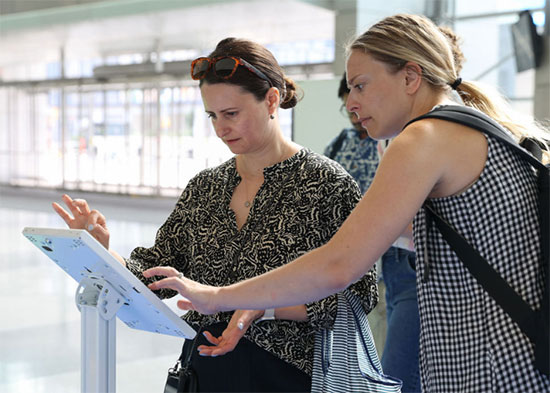
Register for Texworld and Apparel Sourcing NYC Today
Registration for Texworld NYC, Apparel Sourcing NYC and Printsource is now open. We look forward to welcoming you to the next edition of the show, which will be held January 21-23, 2025 at the Javits Center in New York City. The co-located shows are your one-stop resource for shopping the latest products from your favorite textile and apparel vendors, exploring new suppliers and materials, and learning from peers in the industry.
Texworld NYC, the largest textile sourcing event, will feature materials ranging from sustainable textiles to functional fabrics and sophisticated knits to intricate laces, along with findings, trims and accessories. Apparel Sourcing NYC offers buyers the opportunity to shop finished apparel, contract manufacturing, and private-label development across ready-to-wear for men, women, children and accessories. Additionally, Printsource showcases hundreds of collections by international surface and textile design studios across apparel, paper goods and home textiles.
This edition of the show will once again feature Trend+, a new digital component of the event that allows attendees to research product details and order samples without leaving the show floor. Plus, Material Exchange’s new AI sourcing assistant, Frank, will be on hand to help buyers zero in on the best materials for their collections. Can’t wait for the show? Feel free to give Frank a try anytime here.
Texworld will also welcome back the Next-Gen Innovation Hub, a space dedicated to innovative, high-performing, and sustainable fiber and material alternatives. Attendees are encouraged to explore the many options representing a less impactful, more responsible textile future. The Hub brings together exhibitors committed to innovation, sustainability, and ethical practices.
The January show will also feature Made to Move, a featured area for high-performance textiles and activewear. The space is designed to help buyers capitalize on the booming active and outdoor categories with globally sourced, innovative fabrics and apparel that redefine durability, flexibility, and comfort. Made to Move is an essential stop for anyone looking to excel in the world of functional fashion.
Don’t miss out on the largest textile show on the East Coast. Register to attend Texworld NYC, Apparel Sourcing NYC, and Printsource today.
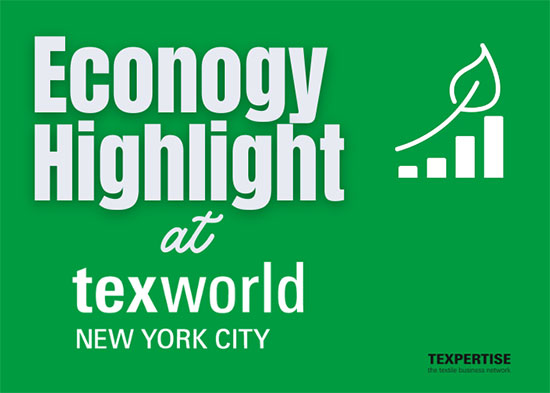
Texworld Tools Make Shopping More Responsibly Easier
Texworld NYC and Apparel Sourcing continues its commitment to sustainability through the introduction of specialty sourcing categories, under the umbrella of Messe Frankfurt’s Econogy initiative. Designed to reinforce the concept that environmentally responsible practices are economically beneficial, Econogy supports sustainable materials and collections. In an effort to bring more transparency to sourcing, the show will highlight products with the Texpertise Econogy certification with a green booth ID, indicating these materials have been verified by a third party.
Additionally, the show will also bring visibility to deadstock with clearly identifiable booth labels. Buyers will be able to easily identify exhibitors with excess fabric that would otherwise go unused. In this way, Texworld is encouraging the use of surplus and unused fabrics, thereby reducing waste and promoting the circular economy.
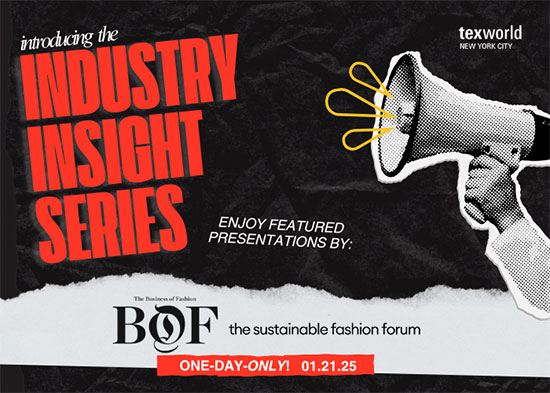
Texworld Presents One-Day-Only Industry Insight Series
We’re excited to announce the launch of the Industry Insight Series at Texworld NYC, this coming Winter 2025 Edition! This event will provide a valuable look at the future of fashion through expert presentations and networking opportunities.
Highlights include:
- Insights from the Business of Fashion on current trends and future directions in the industry.
- A discussion on the importance of sustainability.
- A complimentary networking lunch with industry leaders and peers.
Seats are limited, so secure your ticket now to take advantage of pre-event pricing!
Note: You must be registered for the show to attend.
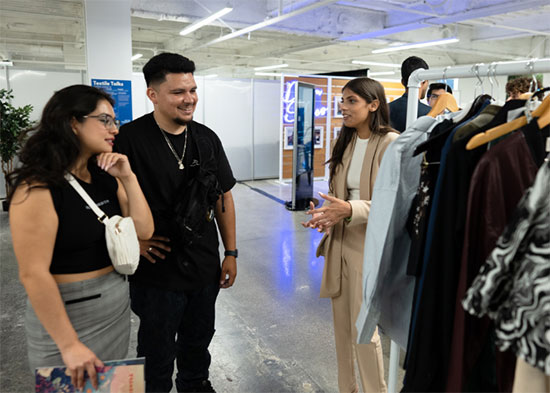
Mark Your Calendars for the Summer 2025 Shows Now
The show dates for the summer Texworld shows on both coasts have been announced.
Texworld NYC, Apparel Sourcing NYC, and Home Textiles Sourcing will take place July 22 - 24 at the Javits Center in New York City.
The third annual Texworld LA and Apparel Sourcing LA will take place July 29 - 31 at the California Market Center in Los Angeles. The Los Angeles show makes the buying and educational features of its East Coast counterpart accessible to the West Coast.

What We’re Reading
Fashion’s Athletic Notes From the Performance and Active Categories
Since the pandemic boost, activewear and athleisure have been a major focus for apparel. California Apparel News shares insiders’ takes on what’s next in the categories and what shoppers are looking for now. As several executives noted, versatility is key with pieces that look office ready but offer fibers and fits that provide the comfort of lounge and workout wear. Additionally, durability was a major refrain, with consumers looking for pieces that offer value over time. Read the story to hear from leaders at Invista Cordura, Brrr, Unifi and more.
Can anything slow fast fashion down? Lawmakers are giving it a go
At the current pace McKinsey & Company predicts clothing and footwear consumption will reach 102 million tons by 2030, up from 62 million tons in 2019. Meanwhile clothing prices are on a race to the bottom with the average price of a garment on Shein set at $14. The LA Times reports this all adds up to too much stuff, which in turn has negative impacts on the people making these garments as well as the planet. Read the article to learn how fast fashion is affecting labor practices and sustainability gains.
Zara Owner Launches 50 Million-Euro Fund to Invest in Textile Innovation
As part of a sweeping overhaul of Inditex’s environmental impact, the company plans to invest 50 million euros into material innovation. Sourcing Journal reports Zara’s parent company is on track to not only reduce its reliance on conventional inputs through the use of recycled fibers and regenerative practices, it has also committed to transitioning 25 percent to fibers that don’t exist yet. Read the article to learn about the partnerships Inditex has forged to make these materials a reality.